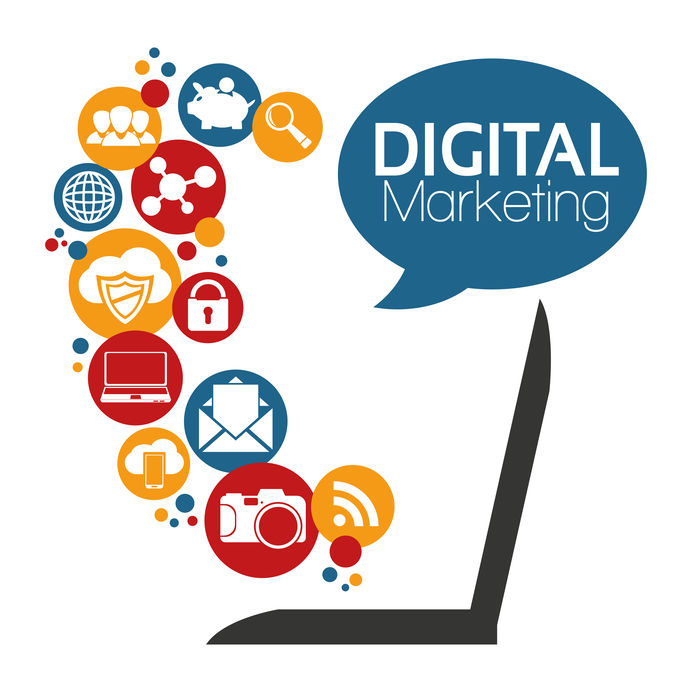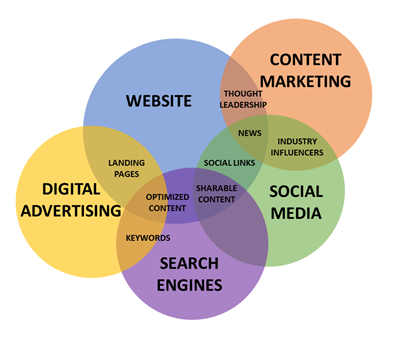
Today, the terms “digital” and “marketing” go hand in hand. Digital marketing is how today’s businesses are reaching the right audiences, with the right messages, through the right channels. And that goal is becoming increasingly complex as the pace of change and increased competition flood the marketplace.
Venn Diagram in Digital Marketing

Think of digital marketing as concentric circles as in a Venn diagram. According to Lucidchart.com, a Venn diagram is the use of “overlapping circles or other shapes to illustrate the logical relationships between two or more sets of items. Often, they serve to graphically organize things, highlighting how the items are similar and different.”
When it comes to marketing, the concept emphasizes the interconnectedness of tactics. In this context, marketers need to align five sub-categories of digital marketing to make sure their brands, messaging and goals mesh.
- Website: A company’s website is one of its most vital resources. For most businesses, a website is an essential marketing tool that conveys a company’s mission, vision, brand and thought leadership. It provides visitors with valuable information that helps convert prospects to customers. Additionally, with the increase of digital communication and remote workplaces, a website can also serve as a headquarters for business transactions, often more so than a physical storefront or office. Therefore, optimizing your website for a variety of audiences is crucial. Evaluating and fine-tuning your website’s performance require a wide range of skills, including web design, graphic design, copywriting, and analytics to keep track of what is working and what isn’t. Establish KPIs to evaluate performance and keep up with technology to ensure you’re meeting visitor expectations. Paul Slack, CEO of Vende Digital, says buyers in 2021 are looking for “person-centric” websites. “When customers land on your website, they want to know, ‘What’s in it for me?’ Your organization must be able to fulfill that experience in a clear and concise manner,” Slack says. “Tailor content to specific personas rather than the ‘one size fits all’ approach. Investing time in persona development will allow you to give customers a personal and unique experience.”
- Content marketing: Content is an important part of your website, but developing content requires continually refining creative skills to make sure messaging is fresh, engaging, resonates with and provides value to your target audiences. When it comes to content, Digital Marketing Institute advises, “Focus 100% of your attention on reaching people that need you. Businesses need to focus on writing for the small audience of people that truly, often desperately need their help.” Content marketing includes but is not limited to:
- Blogs
- Books and eBooks
- Bylined articles
- Case studies
- Email campaigns
- E-newsletters
- Infographics
- Podcasts and webinars
- Testimonials/success stories
- Videos
- White papers
Each type of content fills its own needs, is distributed in different ways, and reaches diverse audiences. Successful content marketing requires a grasp of medium, messaging and frequency along with writing skills, industry knowledge and data analytics. Combine static content with interactive elements to encourage engagement. Equally important is the selection of platforms where content marketing lives and thrives.
- Social media. Social media is a powerful way for businesses of all sizes to reach prospects and customers. Research shows that 81 percent of B2B decision makers use online communities to make purchasing decisions so social media is a critical component of any marketing plan. A multichannel approach involves building company awareness, sharing content and increasing engagement across a variety of platforms. The major social media platforms include Facebook, LinkedIn, Twitter, Instagram and Pinterest. It’s important to understand that each platform connects with users in different ways and requires consistent maintenance and communication. Oftentimes, social media marketers use additional tools like Hootsuite for ease of management or tools like Spoutsocial for social listening. A social media strategy is necessary to keep efforts brand-aligned, produce consistently shared content and focused on prospect and client engagement.
- Search engines. The subset of digital marketing is comprised of two areas: search engine optimization (SEO) and search engine marketing (SEM). RevLocal, local search marketing experts, breaks down the difference between the two: “SEO is the process of optimizing websites with the goal of receiving organic traffic or gaining more visitors from the Search Engine Results Page (SERP). On the other hand, SEM is a form of online marketing that uses paid advertising and optimization to increase website ranking on the search results page.” Addressing SEO requires a clear understanding of search engine trends and overlaps with website skills. SEM is a kind of promotional advertising that requires a balanced understanding of effective content outreach and target market trends. RevLocal also advises, “take time to evaluate your goals and think about what would be best for your business, not what the business next door is doing.”
- Digital advertising. Thinking about the realms of digital marketing as overlapping circles, digital advertising can take place across a variety of platforms including social media and search engines. Effective advertising requires a specific understanding of those platforms and audiences to ensure budgets are wisely spent. Create an advertising campaign plan that defines audiences, resources, timeline and predicts ROI. Most importantly, create messaging that resonates with audiences. Digital Marketing Institute advises how pay-per-click advertising usually limits character count: “First impressions are everything! To ensure customers convert, you need to achieve maximum impact with minimum copy. When you’re creating your text ads, never forget that they need to be highly targeted, with a persuasive and relevant message.” Make sure content isn’t overly self-promotional and includes a clear call to action. Digital advertising can also appear in other spaces such as online publications, video platforms like YouTube and Vimeo, or other industry websites.
The More You Know…

When it comes to digital marketing, the well-known axiom “the more you know, the more you know you don’t know,” definitely applies. Staying on top of a rapidly changing digital landscape can feel overwhelming. As you build your team or seek external expertise, look at the big picture and be clear about the skill sets you need to execute a robust digital marketing plan that delivers results.
